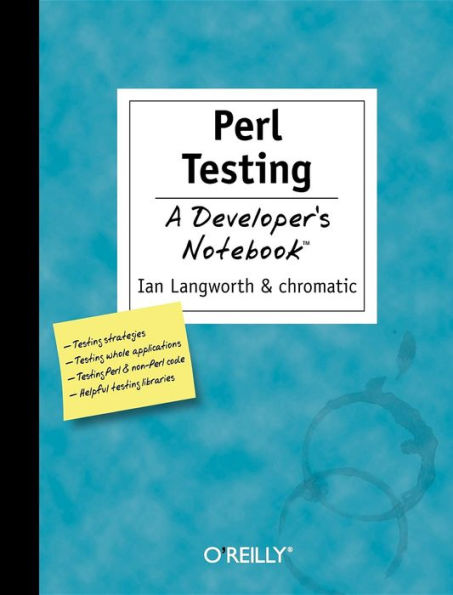
Perl Testing: A Developer's Notebook: A Developer's Notebook
200
Perl Testing: A Developer's Notebook: A Developer's Notebook
200Paperback
-
PICK UP IN STORECheck Availability at Nearby Stores
Available within 2 business hours
Related collections and offers
Overview
Perl has a strong history of automated tests. A very early release of Perl 1.0 included a comprehensive test suite, and it's only improved from there. Learning how Perl's test tools work and how to put them together to solve all sorts of previously intractable problems can make you a better programmer in general. Besides, it's easy to use the Perl tools described to handle all sorts of testing problems that you may encounter, even in other languages.
Like all titles in O'Reilly's Developer's Notebook series, this "all lab, no lecture" book skips the boring prose and focuses instead on a series of exercises that speak to you instead of at you.
Perl Testing: A Developer's Notebook will help you dive right in and:
- Write basic Perl tests with ease and interpret the results
- Apply special techniques and modules to improve your tests
- Bundle test suites along with projects
- Test databases and their data
- Test websites and web projects
- Use the "Test Anything Protocol" which tests projects written in languages other than Perl
With today's increased workloads and short development cycles, unit tests are more vital to building robust, high-quality software than ever before. Once mastered, these lessons will help you ensure low-level code correctness, reduce software development cycle time, and ease maintenance burdens.
You don't have to be a die-hard free and open source software developer who lives, breathes, and dreams Perl to use this book. You just have to want to do your job a little bit better.

Product Details
| ISBN-13: | 9780596100926 |
|---|---|
| Publisher: | O'Reilly Media, Incorporated |
| Publication date: | 08/14/2005 |
| Pages: | 200 |
| Product dimensions: | 7.00(w) x 9.19(h) x 0.55(d) |
About the Author
He has contributed a handful of modules to the CPAN, most of which are Kwiki-related. He has spoken at Perl-related conferences as LISA and YAPC. Ian is also the author surprisingly widespread utility, Cadubi, which is packaged for many free operating systems.
Ian is currently studying Computer Science and Cognitive
Psychology at Northeastern University. Whilst pursuing a degree, he's participating in an volunteer systems administration group and working toward making higher code quality and robustness an easier goal to achieve.
He currently resides in Boston, Massachusetts where he participates in the local Boston Perl Mongers group and lives precariously close to Fenway Park.
chromatic is the technical editor of the O'Reilly Network, covering open source, Linux, development, and dynamic languages. He is also the author of the Extreme Programming Pocket Guide and Running Weblogs with Slash, as well as the editor of BSD Hacks and Gaming Hacks. He is the original author of Test::Builder, the foundation for most modern testing modules in Perl 5, and has contributed many of the tests for core Perl. He has given tutorials and presentations at several Perl conferences, including OSCON, and often writes for Perl.com, which he also edits. He lives just west of Portland, Oregon, with two cats, a creek in his backyard, and, as you may have guessed, several unfinished projects.
